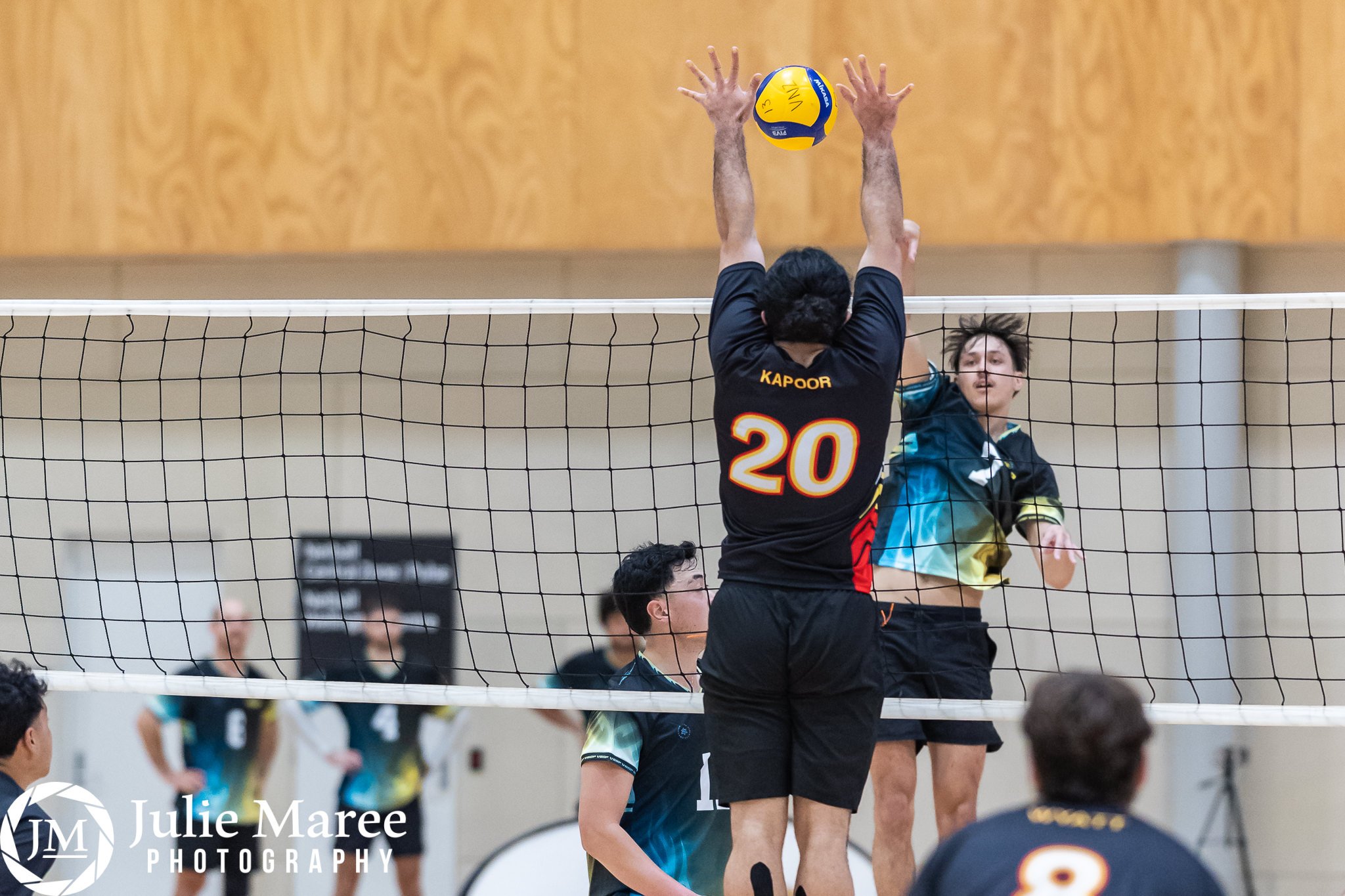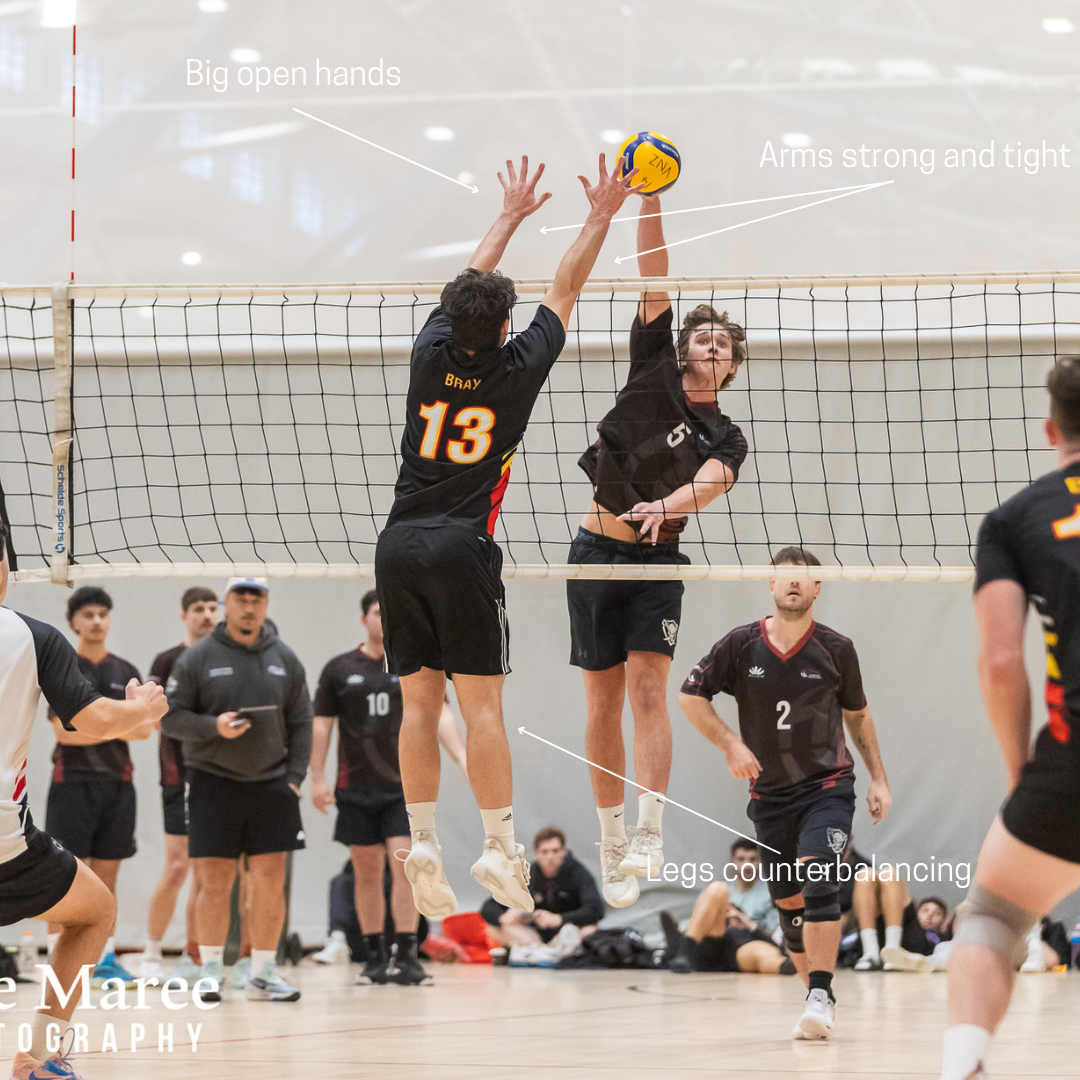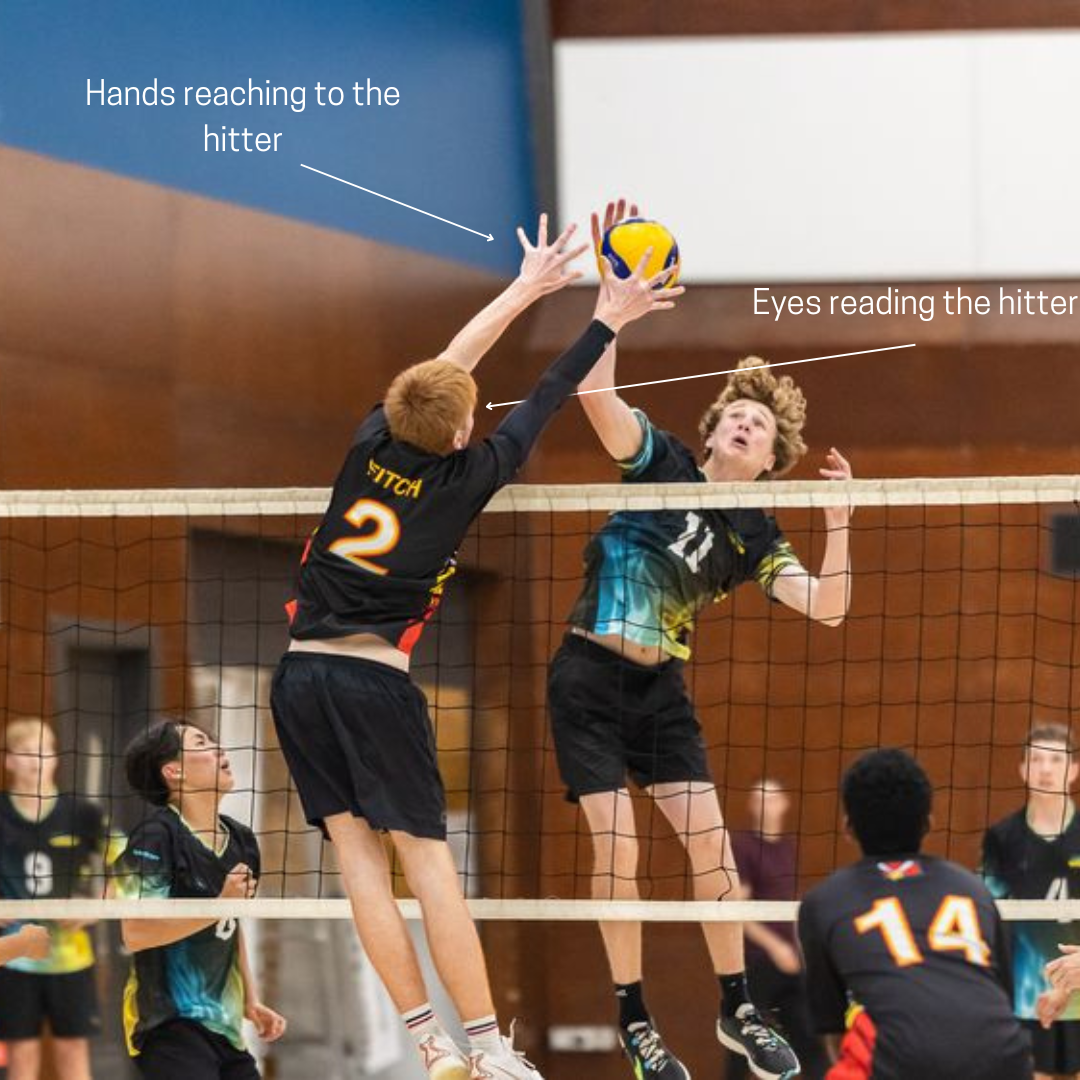
BLOCKING is one of the most difficult skills to execute in volleyball due to having many variables in the action. The three main elements of blocking is footwork, handwork and eyework. Blocking is a form of team defense so we must learn and practise it together as a team. Blocking is our first line of defense, our first chance to stop an opponent’s offense so the execution of the skill is incredibly important.
Footwork
Your blocking footwork is incredibly important because it ensures that we can move as quickly and efficiently to block the opponent’s offense. Blockers only have seconds (sometimes less) to get their feet to the block.
-
Blocking is an incredibly quick action so you must start in a ready position and be able to release as quickly as possible, giving us a better chance to get a block.
Start in an athletic, loaded position. Blocking is a game of seconds so we must be ready to move.
Feet slightly wider than your shoulders.
Bend at the knees
Weight forward and back straight and looking up.
Hands out in front.
-
The basic footwork is the Crossover 3. This footwork is used primarily by the middle blocker but can also be used by a pin blocker as well if they are bunching in the middle. For pin blockers in a spread formation, use shuffle steps or just use a crossover step without the directional step.
Directional Step
First step is the Directional step (takes you to the direction of the block). Right foot if going to the right or Left foot if going to the left.
Crossover Step
Second step is the crossover. This step will give you distance to get to the block. The crossover step is variable which means you take a small step if you are close or a big if you’re trying to make a bigger distance.
Close Step
The final step is the close step. This step stops your lateral movement and shifts it into vertical (to jump). Your foot should be 45 degrees to the net in this step.
After blocking, land on your feet with your knees slightly bent to absorb the impact, and be ready to transition quickly back into play.
-
Emergency blocking refers to when you are late to a block or made an incorrect read and need to try make up for time and distance.
Crossover 2
Directional step, Crossover, then knee drive to jump. The Crossover 2 gives you speed when you are late to the block.
Crossover 5
Shuffle, Shuffle, Directional, Crossover, Close step. The Crossover 5 gives you distance.
Quick Shuffle 2
Shuffle, Shuffle. This allows you the ability to quickly close the block.
Handwork
Your handwork and armswing is essential for maximising reach, creating a solid blocking surface, and enhancing the effectiveness of your blocking. Having a good armswing also minimises net touches when completing your blocking action.
-
It's important that you start in an athletic position so that you are ready to initiate the blocking sequence as quickly as possible.
Start with a balanced stance, feet shoulder-width apart, knees slightly bent, and weight on the balls of your feet.
Keep your arms raised and elbows bent at about 90 degrees, ready to initiate your directional step.
-
Your arms work in tandem with your footwork.
Start with your hands forward when taking your Directional step.
Then back in a parallel and compact position when taking your Crossover step.
And finally forward to bring your momentum vertically when bringing your Close step forward.
Your arms go straight into the block - avoid looping like a rainbow.
-
Getting your hands up and over the net into the opponent’s space is important.
You go from armswing straight to reaching over the net.
Make sure you have big open hands to increase the surface area to get a touch on the ball.
Both arms parallel with spacing but not too much that the ball will go through your arms.
When you reach over the net, you want to counter balance that by kicking your legs creating a ‘C' shape with your body.
Drop outside shoulder to redirect the ball back into the court.
Head up not down (look at the hitter).
Eyework
Your eyework or reading is an important skill in blocking (as well as defense). Reading allows us to gain useful information on the opposing side of the net so we can anticipate their next action. When we do this, we are less surprised.
-
The visual cue that we can see from the pass is whether it is in system (good pass) or out of system (bad pass). If there is a bad pass, then you eliminate the middle attack (filtering the information) as the ball is off the net and the middle can't be set.
IN SYSTEM (GOOD PASS): All opponent's attack routes open (setter has all attack options available). If you are a middle, you must put your hands higher to prepare to stop their middle attack.
OUT OF SYSTEM (BAD PASS): The pass is off the net or setter takes the first ball. Therefore, the middle is out of the offense (so we eliminate them) and we prepare to move laterally (to block the pins). If you are blocking, put your hands down and be ready to move to the pins.
-
The visual cue that we can see from the setter is where they contact the ball in relation to their midline. From there, we can predict where they will set the ball based on that visual cue.
SETTER TAKES BALL IN FRONT OF THEIR MIDLINE
When the setter contacts the ball in front of their midline, they will usually set in front of them (toAttack Zones A and B. As a blocker, you will make an early move to block those zones. If the setter is low/braced or contacts the ball in front of their eyes, they will likely set a middle attack in Zone A (shoot or quick). If you see this, then you eliminate the hitters behind the setter (filtering). If you are a defender in the back court, you might step in to try dig the quick attack or move to dig the outside hitter.
SETTER CONTACTS BALL AT OR BEHIND THEIR MIDLINE
When the setter contacts the ball at or behind their midline, they are more likely to set the ball behind them to Attack Zones C and D. As a blocker, you might make an early move to block the middle running a C or slide or the opposite hitting a D set. Generally, if the setter is in a more upright stature with their feet together, they are more likely to set the C, but if their back is more arched, they are more likely to push the set to the opposite. As a digger in the back court, you prepare to dig a potential attack coming from zones C and D and make an early move.
-
What we can read from the hitter is whether they will spike the ball or tip it. If they spike it, will it be a line or angle hit. If they tip it, then what type of tip will it be.
VISUAL CUES FOR SPIKING
If they spike the ball; Will it be line or angle attack? If they tip the ball; What type of tip will it be?
There is a lot of information we can gather from the visual cues of an attacker. Instead of looking for every cue, we look at only a few to gain more information. If they spike the ball, it is easiest to look for good hitting techniques.
When we can see one or more of these visual cues, we can predict that they will likely spike the ball.
As a blocker, you would want to front them to block a powerful attack. Once we can process that they will spike the ball, we need to predict whether the spiker will hit down the line or cross court into the angle.
Hitters will likely hit where the set takes them. So if the set is inside and they take an angular approach, they are more likely to hit angle. If the ball is wider and they have a linear approach, they are more likely to hit down the line.If you are blocker, then you make a decision whether to block line or angle based on the visual cues you've just seen. Remember, good attackers have a variety of shots so we shouldn't go into a game just blocking line or just blocking angle.
VISUAL CUE FOR TIPPING
Now that we have established what it looks like to spike, we will look at the visual cues lending to a tip. Reading a player will tip the ball is easy but the difficult part is understanding what type of tip it will be and making your defensive move from that.
It is important that we can read the type of tip based on the visual cue of the attacker because then we can move forward (for a shallow tip) or deeper (for a push tip).
1) When the attacker's arm is straightened: They are likely to do a short tip - move forward on defense.
2) When the attacker's arm is bent and hand is under the ball: the court. They are likely to do a deep tip/push.
3) When the player has a bent elbow but the hand is on top of the ball: likely to be a short roll over the top of the block, move forward on defense.
Blocking Principles
-
Blocking is our first line of defense, our first chance to stop or slow down the opponent's offense so it is very important. Remember, blocking is a form of team defense so always practise it together.
-
Short blockers does not automatically mean they are bad blockers. Blocking is to do with your techniques, footwork and reading skills, rather than being predetermined by your height.
-
The role of the pin blocker is deciding where to block and the timing, whilst the role of the middle blocker is to seal the block with the pin by being hip to hip and shoulder to shoulder.
-
We use swing blocking as it allows for greater dynamism as blocking is a very dynamic move. For more inexperienced players, you can use static blocking (where we don't swing our arms when moving).
-
Block with your palms as it allows for better control and less chance to get tooled whilst having the ability to direct the ball back into the opponent's court.
-
Blockers need to be at max reach when the hitter contacts the ball. Delay for backrow attack or when the ball is hit with distance from the net. Aim to block lower for shorter attackers, and higher when blocking someone with a higher reach.
-
Hitters tend to hit where the set takes them. Read the hitter's approach and line up your block accordingly. They are more likely to hit crosscourt on an angular approach and down the line on a linear approach.
-
Reaching over the net is more important than how high you can get. Adjust your block reach in accordance to the hitters, reach higher if the attacker has a higher reach, or lower if the attacker has a lower reach.
-
Your eyes and hands work independently from each other. Your eyes look for visual cues (reading) to see what is happening on the other side of the net, and your arms and hands reach to where you think the attack will be.
-
Reading is a huge part of blocking. Reading is the process of gathering information based on the visual cues that you see, filtering (process of elimination) that information and making a plan on what you will do based on what you saw.



